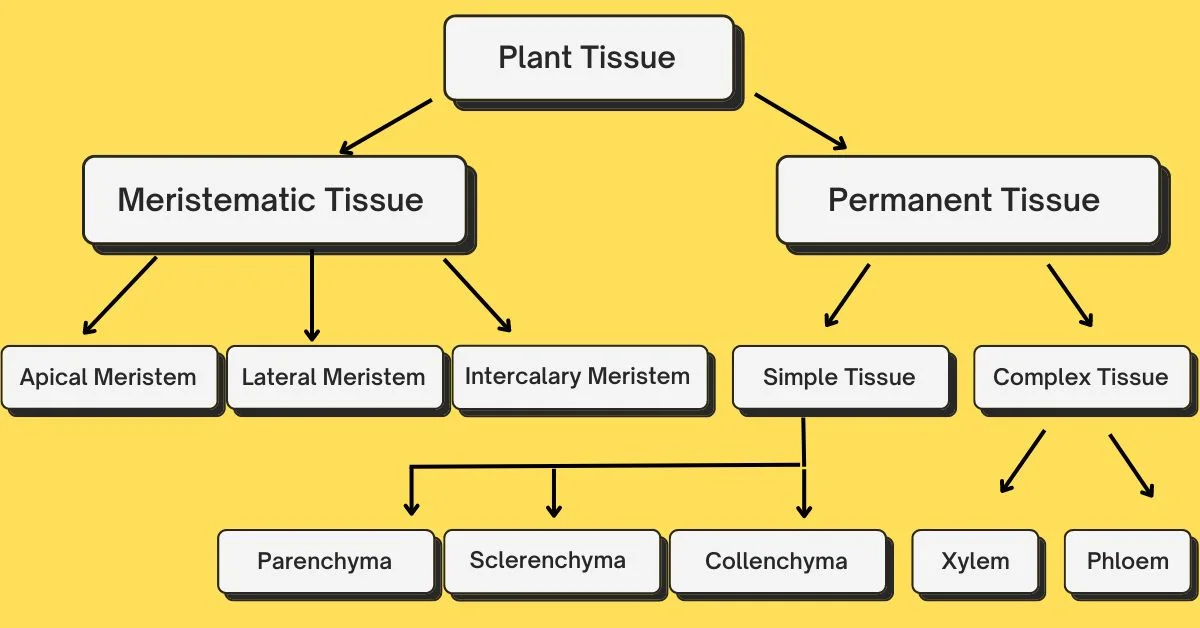Plant Tissue is a organization which is simple and targeted towards the stationery habit of plants. Many of the them are dead. For example, Cork. Growth is confined to certain areas. Less maintenance energy required. Plants grow continuously throughout life. Anaerobic respiration occurs in cytoplasm of plant as they don’t have mitochondria. In this article further we are going to know types of plant tissues, classification of plant tissue, plant tissue culture and plant tissue flow chart.

Classification of Plant Tissue
- Meristematic :
- Apical
- Intercalary
- Lateral
- Permanent :
- Simple :
- Parenchyma
- Collenchyma
- Sclerenchyma
- Complex Permanent :
- Xylems
- Phloem
- Simple :
Related Posts :
1. what is meristematic tissue class 9
Meristematic tissues in plants are are composed of immature and undifferentiated cells, each meristematic cell has abundant cytoplasm and prominent nuclei, Vacuoles are small or absent. It is responsible for cell division, growth and thickness of plants and found in specific region of the plants.
Types Of Meristematic Tissue
(a). Apical meristem
- Where is apical meristem found : Apical Meristem are present at root and shoot tip and it helps in growth of the plant.
- Responsible for primary growth in plant i.e. increase in the length of the plant.
- Shoot apical meristem is responsible for the growth in height.
- Root Apical meristem is responsible for the growth in depth.
(B). Intercalary meristem
- Location of intercalary meristem is at the inter node or base of leaf.
- Function of intercalary meristem is to provide growth between the nodes.
- It is also responsible for regrowth after injury.
(C). Lateral meristem
- Lateral meristem location is between xylem and phloem and cork and also present at the lateral side of the plant.
- Lateral meristem is responsible for secondary growth i.e. thickness of plant body example root.
- Also known as the cambium.
2. Permanent Tissue
Permanent tissue define as mature tissue because it has completed its active growth and division phases that’s why growth has been stopped either completely or for time being. Cells within them may be active or dead and they are generally living which are thin walled in nature.
Types Of Permanent tissue
2(a). Simple Permanent Tissue
- They are made up of just one type of cell.
- These tissues consist of cells that have similar structures and perform specific functions.
types of simple permanent tissue
Parenchyma tissue are living and their walls are made up of cellulose. Function of parenchyma is to help in storage and also carry out photosynthesis if chlorophyll is present in them. If parenchyma tissue contains air then they are known as aerenchyma and this helps in buoyancy of plants which are helpful for water floating plants e.g. water hyacinth.
Collenchyma tissue function is to provide help in giving mechanical support, turgidity and flexibility to the plant.
Sclerenchyma tissue are mostly dead in nature and function of sclerenchyma is tp provide protection to the plant from any type of external damage. They are mostly present in the fibers of coconut cells. They are mostly present in the form of fibres and sclereids.
2(b). Complex Permanent Tissue
These tissue are mostly dead in nature. Xylem and Phloem is a Complex Permanent Tissues. Xylems responsible for transport of water and salt in upward directions from root to leaves. Phloem responsible for transport foods that are synthesized in leaves in different parts of the plants.
Plant Tissue culture
It is a technique in which a whole new plant is generated from culturing of tissue (group of cells) of a plant in artificial environment ; this group of cell can be taken from leaf, fruit or stem. This process of making whole new plant is called plant tissue culture technology. Father of this technique is Gottlieb Haberlandt.
Also Read : 5 Things We Get From Plants With Chart
plant tissue culture ppt
Conclusion
The article concludes that Plants tissue are classified into Meristematic and Permanent, having their own features. The Meristematic having immature and undifferentiated cells are further divided into Apical, Intercalary and Lateral which helps in growth whereas Permanent is made up of only one type of cell and is of 2 types: Simple and Complex (classified into Xylem and Phloem which helps in transportation of water and food).
FAQs
What are the 3 types of plant tissues?
Meristematic and permanent (or non-meristematic)
What are types of plant tissues?
- Meristematic
- Permanent tissue
- Simple Tissue
- Parenchyma
- Collenchyma
- Sclerenchyma
- Xylem
- Phloem
Difference between plant tissue and animal tissue?
Most of the plant tissue have dead cells that’s why require less energy whereas animal tissues are living cells and need more energy.




